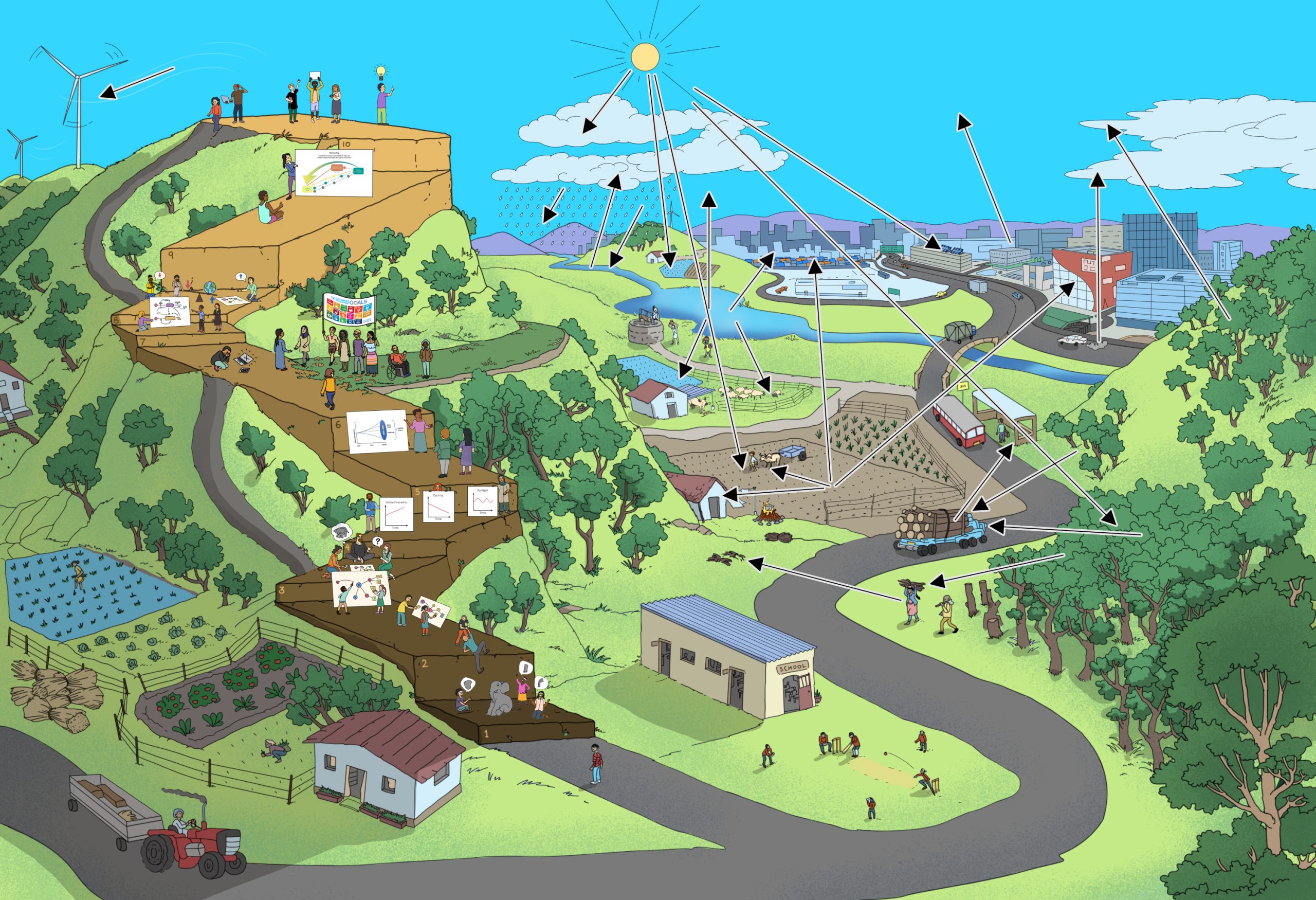Understanding Causation
Suitable for Steps 3, 4 and 5
Duration
90 minutes
Material Needed
Writing materials
Group size
Up to 30
Objective
To help learners understand causal relationships between elements of a system
Description
To help learners understand causal relationships between elements, you may engage them in a few simple group activities and explain as you go along.
- Cause and effect (Causal) links
We know that elements in a system are interconnected. These interconnections may be of different types. One type of interconnection is a cause-and-effect relationship. That is, a change in state of one element may cause one or more elements connected to it to change.
Conduct these activities with the learners:
Exercise 1
Ask learners to carry out these simple exercises:
- Bend both your hands and keep them in a position, parallel to ground.
- Now let us consider that the movement of your right hand will affect the movement of your left hand. The, left hand will move only if the right hand moves. And if right hand remains stationary, then the left hand will also remain stationary.
- The movement of the left hand is an effect, and the movement of the right hand is the cause of that effect.
- This type of relation is called ‘causation’ because a change in state of the right hand (cause) is causing the state of left hand to change (effect).
Exercise 2
- Read the following cause and effect relationships
- Write why you agree or do not agree with each of these relationships
- Your friends might have different answers; share your work with them
Water quality -> Biodiversity in a pond
Food shortage -> Food availability
Hunger -> Chips eaten
Advertising -> Jeans sold
Advertising -> Chips sold
Explain to the learners:
- It is because of such cause-and-effect connections that an intervention intended to change the state of some system element (implementation of malaria eradication program) can eventually alter many other system elements (such as mosquito population, migratory human and livestock populations, stock of minerals and forests cover and vegetation type etc.).
- Here are examples of such relationships, indicated by drawing an arrow between the two.
Amount of food intake -> Body Weight
Number of saplings planted -> Number of tree

- Thus, the causal links shown in point 2 above can be read as “amount of food intake causes the body weight to change”, and “the number of saplings planted causes number of trees to change.”
- When studying a situation from a system’s perspective by using the Cause-Effect tool, the focus is to look for and capture the “cause-effect” (or causal) relationships between system elements. Some elements may not be connected in cause effect relationships, while others are.
- In some cases, it may appear that elements have a cause-and-effect relationship, but further investigations may reveal that there is no real cause effect relationship. On the other hand, no cause-effect may be visible, but further investigations may reveal that such a relationship is in fact present.
Note that correlation does not necessarily mean causation.
A correlation exists between two variables, when one variable changes, the other variable also changes.
Causation is when a change in one variable causes a change in the other variable.
- In the world, we find that most elements are connected with several other elements and it is possible that each one of them could be affected by several others.
While drawing causal links between two elements, the influence of all the other elements must not be mixed up together. For instance, one can say that the state of forest resources changed because of government policies.
This is not untrue; however, aggregating several influences together could give us only a limited understanding and short insight to intervene in the system. Therefore, each one of the influences should be considered independently. (See Figure 1.11)
Also, only direct influences must be considered. For instance, because greater number of learners were willing to plant saplings, greater number of saplings were planted and thus it caused number of trees to change. While describing this, one may get tempted to establish a link between number of learners willing to plant sapling and number of trees. This must be avoided. Instead, a series of influences can be drawn, by considering each relationship independently and in isolation.
See a similar example shown in Figure 1.12. The correct mutual interplay of all influences is found later as we go on developing the diagram. The loss of canopy cover in the forests of Uttara Kannada district in India caused the spread of the invasive plant species Eupatorium, which led to an increase in the risk of forest fires.

Positive and negative causation
When we say an element causes another to change its original state, the change can occur in two possible ways.
Positive Causation is when the state of the second element increases due to an increase in the first element and decreases with a decrease in the state of the first element. This means that the second element changes in the same way as the former changes. We use ‘+’ sign placed above arrowhead to indicate this type of change.
Negative Causation is when the second element (i.e., effect) changes in the opposite manner. That is, if an increase in the state of the first element causes a decrease in the state of the second element and a decrease in the state of the first element causes an increase in the state of the second element. We use ‘- ‘sign placed above arrowhead to indicate this type of change.
The activity below would help illustrate the concept.
Activity
Draw a plus sign on a paper and pin the paper on your chest. What is the meaning of this sign? This means that your left hand will move towards the same direction where your right hand moves. This means that if you moved your right hand in the upward direction, then your left hand will also go in the upward direction. If the right hand comes down, the left hand will also do the same. This type of relation is called ‘positive causation’. The left-hand acts as per the actions of right hand.
Now pin a minus sign on your chest. Your left hand will move in the opposite direction of the right hand. If you move your right hand up, then the left will go down! And if the right moves down, then the left will move up. This type of causation is called ‘negative causation’.
Draw the learners’ attention to the fact that though we use the words positive and negative, it does not mean that positive is correct and negative is wrong. We are using plus and minus signs only to show whether the second element (left hand) changes in the same way that the first (right hand) does or in the opposite manner.
Read out the following causal connections to the learners one by one and write them on the blackboard. Ask the learners whether the causation is positive or negative.
Mark a ‘+’ sign at the top of arrowheads if the learners think they are positive causations and a ‘–‘ sign if they think they are negative causations
- Chances of death due to malaria ->Deaths due to malaria
- Wood processed by paper mill ->Paper produced
- Lands submerged under reservoirs -> Lands available for agriculture
- Births -> Population
- Deaths -> Population
- Livelihoods -> Pressure to mitigate
- Food availability-> Food shortage
- Resources available -> Concern about conserving resources
Contribution to Systems Thinking competence
Understanding cause and effect relationships and learning how to present them is the foundation of the Systems Thinking approach. We can recognize that events, situations, or problems are not stand alone, that occur on their own without a reason. Rather, they are part of a complex chain of events and cause and effect relationships. Training the mind to understand cause and effect is about seeing beyond what may appear to be isolated events, to identify patterns and connections. It helps the learners understand systems and prepare systems models to share their thinking with others.

